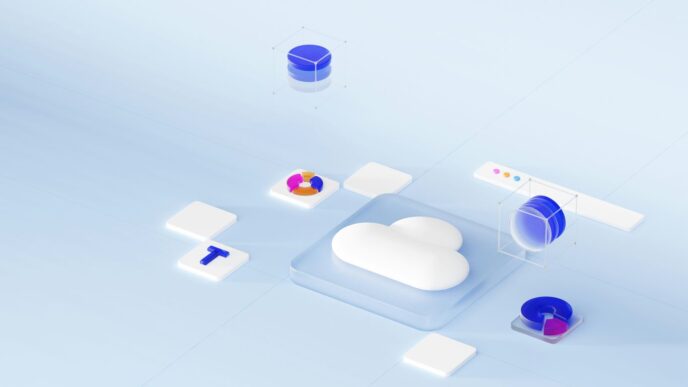Artificial Intelligence (AI) is changing the way we farm, making agriculture smarter and more efficient. With tools that help monitor crops, predict weather, and automate tasks, farmers can produce more food while using fewer resources. This article explores how AI is transforming farming practices and what it means for the future of agriculture.
Key Takeaways
- AI helps farmers make better decisions by analyzing data quickly.
- Smart machines and robots are taking over repetitive tasks in farming.
- AI can monitor crop health in real-time, spotting problems early.
- Using AI can save money and increase food production.
- AI is essential for sustainable farming, helping to protect the environment.
The Role of AI in Modern Agriculture
Artificial Intelligence (AI) is changing the way we farm today. It helps farmers make better decisions and use resources more wisely. Here are some key areas where AI is making a difference:
Transforming Traditional Farming Practices
- AI tools are replacing old methods, making farming more efficient.
- Smart machines can do tasks like planting and harvesting, which saves time.
- Farmers can focus on planning and managing their farms instead of just manual work.
Enhancing Decision-Making with Data
- AI uses data to help farmers understand their crops better.
- With real-time information, farmers can predict weather changes and crop needs.
- This leads to better planning and higher yields.
Optimizing Resource Allocation
- AI helps in using water, fertilizers, and other resources more effectively.
- By analyzing data, farmers can reduce waste and save money.
- This not only benefits the farm but also helps the environment.
AI is not just a tool; it’s a partner in farming that helps us face challenges like climate change and food shortages.
In summary, AI is reshaping agriculture by making it smarter and more sustainable. As technology continues to evolve, the future of farming looks promising with AI at the forefront.
AI-Powered Crop Monitoring and Disease Detection
Real-Time Crop Health Monitoring
AI technology is changing how farmers keep an eye on their crops. With real-time monitoring, farmers can quickly see how their plants are doing. This helps them make better decisions about watering, fertilizing, and protecting their crops. Drones and sensors collect data that shows the health of the plants, allowing farmers to act fast if something is wrong.
Early Disease Detection and Prevention
Detecting diseases early is crucial for saving crops. AI can analyze images of plants to spot signs of disease before they spread. For example, systems like Trapview can identify pests and diseases by using cameras and machine learning. This means farmers can take action quickly, reducing the need for chemical treatments and improving yields.
Improving Crop Yields with AI
AI not only helps in monitoring but also boosts crop yields. By analyzing data on soil health, weather, and crop conditions, AI can suggest the best times to plant and harvest. This leads to better quality crops and higher production. Here are some benefits of using AI in crop management:
- Increased efficiency in resource use
- Better pest control through early detection
- Higher yields due to optimized growing conditions
AI is transforming agriculture by providing farmers with tools to monitor and manage their crops more effectively. This leads to healthier plants and more sustainable farming practices.
| Benefit | Description |
|---|---|
| Increased Efficiency | Optimizes resource use for better productivity |
| Early Detection | Identifies pests and diseases before they spread |
| Higher Yields | Improves crop quality and quantity |
Automation and Robotics in Agriculture

Autonomous Tractors and Machinery
Automation is changing the way farming is done. Driverless tractors and other machines are now able to work the fields without human help. This technology helps farmers save time and reduce labor costs. Here are some benefits of using autonomous machinery:
- Increased Efficiency: Machines can work longer hours without breaks.
- Precision: Automated systems can perform tasks with high accuracy.
- Cost Savings: Reduces the need for manual labor, which can be expensive.
AI-Driven Harvesting Robots
Harvesting crops is a tough job, but robots are making it easier. These AI-driven robots can pick fruits and vegetables quickly and accurately. They can work in various weather conditions and help farmers gather their crops faster. Some key points include:
- Speed: Robots can harvest crops much faster than humans.
- Consistency: They provide uniform quality in harvesting.
- Reduced Waste: Robots can minimize damage to crops during harvesting.
Smart Irrigation and Fertilization Systems
Water is essential for crops, and smart systems are helping farmers use it wisely. AI-powered irrigation systems can monitor soil moisture and weather conditions to decide when and how much to water. This leads to:
- Water Conservation: Reduces water waste by only using what is needed.
- Better Crop Health: Ensures plants get the right amount of water.
- Cost Efficiency: Lowers water bills and improves crop yields.
In the future, automation and robotics will play a crucial role in making farming more efficient and sustainable. By embracing these technologies, farmers can tackle challenges like labor shortages and climate change effectively.
Overall, automation and robotics are transforming agriculture, making it more efficient and sustainable. As technology continues to advance, we can expect even more innovations in the farming sector.
AI in Precision Farming
Optimizing Planting and Harvesting
AI is changing how farmers plant and harvest crops. By using data-driven insights, farmers can determine the best times to plant seeds and when to harvest. This helps in maximizing crop yields and reducing waste. Here are some key benefits:
- Increased Efficiency: AI analyzes weather patterns and soil conditions to suggest optimal planting times.
- Resource Management: It helps in using water and fertilizers more effectively, ensuring crops get what they need without excess.
- Yield Prediction: AI can forecast how much crop will be produced, helping farmers plan better.
Soil Health and Nutrient Management
Maintaining healthy soil is crucial for farming. AI tools can monitor soil conditions and recommend nutrient applications. This leads to:
- Improved Soil Quality: Regular monitoring helps in maintaining the right pH and nutrient levels.
- Targeted Fertilization: AI can suggest specific areas that need more nutrients, reducing waste and cost.
- Sustainable Practices: By optimizing nutrient use, farmers can minimize environmental impact.
Weather Prediction for Better Planning
Weather can greatly affect farming. AI helps farmers prepare for changes in weather by providing accurate forecasts. This includes:
- Real-Time Updates: Farmers receive alerts about sudden weather changes, allowing them to take action.
- Long-Term Forecasting: AI analyzes historical data to predict seasonal weather patterns, aiding in planning.
- Risk Management: By understanding potential weather risks, farmers can make informed decisions to protect their crops.
AI in precision farming is not just about technology; it’s about making farming smarter and more sustainable. By using AI, farmers can ensure they are making the best decisions for their crops and the environment.
Challenges and Solutions in AI Adoption
Overcoming Technological Barriers
Adopting AI in agriculture can be tough due to limited infrastructure. Many farms lack the necessary tools and systems to implement AI effectively. To tackle this, AgTech providers can start with simpler technologies, allowing farmers to gradually adapt. For example, introducing an agricultural trading platform can help farmers ease into more complex AI solutions later on.
Educating Farmers on AI Benefits
Many farmers are not familiar with AI, which can lead to hesitation in adopting new technologies. Training programs and workshops can help bridge this gap. Here are some steps to consider:
- Workshops: Organize sessions to explain AI tools and their benefits.
- Hands-on Training: Provide practical experiences with AI technologies.
- Success Stories: Share examples of successful AI implementations in agriculture.
Addressing Data Privacy Concerns
As AI becomes more common, concerns about data privacy and security grow. Farmers need to be assured that their data is safe. Here are some strategies to enhance trust:
- Clear Regulations: Establish guidelines for data use in agriculture.
- Security Measures: Implement strong cybersecurity protocols.
- Transparency: Keep farmers informed about how their data is used.
The journey to adopting AI in agriculture is not just about technology; it’s about building trust and understanding among farmers. By addressing these challenges, we can pave the way for a more efficient and sustainable agricultural future.
AI for Sustainable Agriculture
Reducing Environmental Impact
Artificial Intelligence (AI) is playing a crucial role in making farming more sustainable. By using AI technologies, farmers can significantly lower their environmental footprint. For instance, AI helps in monitoring soil health and optimizing water usage, which leads to less waste and better crop yields.
Promoting Resource Efficiency
AI systems can analyze data to ensure that resources like water, fertilizers, and pesticides are used efficiently. Here are some ways AI promotes resource efficiency:
- Precision application of fertilizers and pesticides based on real-time data.
- Smart irrigation systems that adjust water usage according to weather conditions.
- Data-driven decisions that help farmers understand the best times to plant and harvest.
Supporting Climate-Resilient Farming
AI also aids in developing farming practices that can withstand climate change. For example, farmers can use AI to:
- Predict weather patterns and adjust planting schedules accordingly.
- Monitor crop health to detect issues early, reducing losses.
- Implement sustainable practices that enhance soil health and biodiversity.
By integrating AI into agriculture, we can create a more sustainable food system that benefits both farmers and the environment.
In summary, AI is not just about increasing productivity; it’s also about ensuring that farming practices are sustainable and environmentally friendly. The future of agriculture depends on our ability to harness these technologies effectively.
AI in Livestock Management
Monitoring Animal Health
AI technology is changing how farmers keep track of their animals. With smart sensors and cameras, farmers can monitor the health of their livestock in real-time. This helps in:
- Detecting illnesses early
- Tracking feeding habits
- Monitoring activity levels
Optimizing Feed and Nutrition
Using AI, farmers can analyze the nutritional needs of their animals. This leads to better feed management, which can:
- Reduce feed costs
- Improve animal growth rates
- Enhance overall health
Enhancing Breeding Programs
AI can also help in breeding decisions. By analyzing genetic data, farmers can:
- Select the best breeding pairs
- Predict offspring traits
- Increase the quality of livestock
AI is not just a tool; it’s a partner in farming, helping farmers make better decisions for their livestock.
| Benefit | Description |
|---|---|
| Health Monitoring | Early detection of diseases |
| Feed Optimization | Cost-effective and nutritious feed management |
| Breeding Efficiency | Improved genetic selection |
Economic Impact of AI in Agriculture

Artificial Intelligence (AI) is changing the way farming works, leading to significant economic benefits. Farmers are now able to make smarter decisions that can save money and increase productivity.
Cost Savings and Efficiency Gains
- AI helps farmers reduce costs by optimizing resource use.
- Predictive analytics can forecast crop yields, allowing for better planning.
- Automation of tasks like planting and harvesting saves time and labor costs.
Boosting Agricultural Productivity
- AI technologies can increase crop yields by 10-25%.
- Real-time monitoring of crops helps in identifying issues early, reducing waste.
- Efficient irrigation systems powered by AI can minimize water usage.
Market Trends and Future Predictions
| Year | AI in Agriculture Market Size (in Billion $) | Growth Rate (%) |
|---|---|---|
| 2023 | 1.7 | – |
| 2028 | 4.7 | 24.8 |
| 2030 | 8.38 | – |
The integration of AI in agriculture is not just a trend; it’s a necessity for future food security. By embracing these technologies, farmers can ensure a sustainable and profitable future.
AI is not just about technology; it’s about transforming the agricultural landscape for better efficiency and sustainability. As farmers adapt to these changes, the economic impact will continue to grow, paving the way for a more resilient agricultural sector.
AI-Driven Innovations in Crop Breeding
Genomic Selection and Gene Editing
AI is changing the way we breed crops. By using advanced algorithms, scientists can analyze large amounts of genetic data to select the best plants for breeding. This process, known as genomic selection, helps in creating crops that are more resilient and productive. Gene editing, another powerful tool, allows for precise changes in a plant’s DNA, leading to improved traits such as better nutrition and longer shelf life.
Phenotypic Analysis for Better Traits
AI also helps in monitoring how plants grow and develop. Through phenotypic analysis, AI can track various characteristics of plants, revealing important information about their health and growth patterns. This data is crucial for breeding programs aiming to enhance specific traits, such as drought resistance or disease tolerance.
Developing Disease-Resistant Crops
One of the biggest challenges in farming is crop diseases. AI plays a vital role in identifying potential vulnerabilities in plants. By analyzing data, AI can predict which crops might be at risk and suggest ways to strengthen them. This proactive approach helps farmers protect their harvests and ensures food security.
In summary, AI is revolutionizing crop breeding by making it faster and more efficient. With these innovations, farmers can grow healthier and more resilient crops, which is essential for feeding a growing population.
Key Benefits of AI in Crop Breeding
- Faster development of new crop varieties.
- Improved nutritional value of crops.
- Enhanced resistance to diseases and pests.
By embracing these AI-driven innovations, the agricultural sector can significantly improve its productivity and sustainability.
The Future of AI in Agriculture
Emerging Technologies and Trends
The future of agriculture is bright, thanks to innovative technologies. AI is set to change how we farm by:
- Enhancing crop monitoring with real-time data.
- Automating tasks to reduce labor needs.
- Improving decision-making through data analysis.
Potential for Global Food Security
As the world population grows, the demand for food will increase. AI can help meet this demand by:
- Increasing crop yields through better management.
- Reducing waste with precise resource allocation.
- Supporting sustainable practices to protect the environment.
Integrating AI with Other Technologies
AI is not just a standalone solution; it works best when combined with other technologies. This includes:
- IoT sensors for real-time data collection.
- Drones for aerial monitoring of crops.
- Robotics for automating labor-intensive tasks.
The integration of AI in agriculture is not just about technology; it’s about transforming the entire farming process for better efficiency and sustainability.
In conclusion, the future of AI in agriculture holds great promise. By embracing these changes, farmers can not only improve their productivity but also contribute to a more sustainable food system.
Case Studies of AI in Agriculture
Successful AI Implementations
AI has been making waves in agriculture, with many farmers adopting new technologies to improve their practices. Here are some notable examples:
- Blue River Technology: This company uses AI for weed control, helping farmers reduce herbicide use while maintaining crop health.
- Harvest CROO Robotics: They have developed automated systems for harvesting and packaging, significantly speeding up the process.
- SkySquirrel Technologies: Their AI solutions focus on crop health monitoring, ensuring that crops receive the care they need.
Lessons Learned from Early Adopters
Farmers who have embraced AI technologies have shared valuable insights:
- Start Small: Begin with one or two AI tools to understand their impact before scaling up.
- Training is Key: Educating staff on how to use new technologies is crucial for success.
- Data Matters: Collecting and analyzing data can lead to better decision-making and improved yields.
Scalability and Replicability of AI Solutions
The potential for AI in agriculture is vast. Here’s how these solutions can be scaled:
- Modular Systems: Many AI tools can be added incrementally, allowing farmers to expand their capabilities over time.
- Collaborative Networks: Farmers can share resources and knowledge, making it easier to adopt AI technologies.
- Government Support: Policies that encourage technology adoption can help farmers transition to AI-driven practices.
AI is not just a trend; it’s a transformative force in agriculture. By learning from successful implementations and understanding the challenges, farmers can harness AI to improve their operations and sustainability.
Conclusion
In conclusion, AI is changing the way we farm for the better. It helps farmers work smarter, not harder, by taking care of repetitive tasks and giving them valuable insights. This technology can help tackle big problems like climate change and the need for more food as the world’s population grows. However, it’s important to remember that using AI isn’t just about buying new tools; it requires learning and adapting to new ways of working. Farmers will need to become more like managers of these smart systems rather than just manual laborers. With the right training and understanding, AI can lead to a more efficient and sustainable future for agriculture.
Frequently Asked Questions
What is AI in agriculture?
AI in agriculture refers to the use of technology to help farmers make better decisions. It includes tools that analyze data to improve farming practices.
How does AI improve crop monitoring?
AI helps monitor crops by using sensors and drones to collect real-time data about plant health, soil conditions, and weather.
Can AI help with pest control?
Yes, AI can identify pests early and suggest the best ways to manage them, reducing crop damage.
What are the benefits of using AI in farming?
Using AI in farming can lead to higher crop yields, better resource management, and cost savings.
Is AI easy to use for farmers?
While AI tools can be complex, many are designed to be user-friendly, and training is often provided to help farmers learn.
How does AI affect the job of farmers?
AI changes the role of farmers from manual laborers to planners and managers of smart farming systems.
What challenges do farmers face when adopting AI?
Farmers may struggle with understanding new technologies, data privacy issues, and the need for training.
Will AI help make farming more sustainable?
Yes, AI can help reduce waste, improve resource use, and support environmentally friendly farming practices.












